
Come on board a journey that delves into the intricate politics and ethics of food appropriation within the Israeli settler colonialism of Palestine. In an immersive airline setting, the audience is invited on a trip of culinary reclamation, where the destination is none other than the authentic flavors of native cuisine. Get ready to explore the rich tapestry of taste, culture, and history, all while challenging your perspectives on fabricated identities.This performance is more than just a meal; it’s a multi-sensory experience of the politics of gaslighting and the quest for the decolonial Musakhan.

Center and Edge is an installation sparked by a family photo from the artist’s childhood, taken on the shores of the Dead Sea in Jordan in 1996. The sound and photo installation explores what might be living on the edges of a family portrait and what might be center but rather invisible. Center and Edge maps one photo from a family album of leisurely outings to reveal their unspoken collective memory that underlines three generations of Palestinian displacement.

From My Grandfather’s Chair I Rage is a live performance about the violence of watching an occupied home from afar, from the outside. The performance takes off from the artist’s childhood home in Amman, Jordan, where she grew up watching her grandfather relentlessly monitor news broadcasts to keep up with updates on his home in Palestine. The artist takes the audience on a journey of pilgrimage and puts in motion the inherited rage and helpless monitoring of an intergenerational, exiled Palestinian woman.

Capitalism Doesn’t Exist is a work-in-progress exhibition of three actions that questions objects as symbolic uplifters of surplus interchange in a highly financialized moral economy of contemporary art.

A live seminar performance in which the participants are invited to experience watching a film and listening to a text while discussing the intersections of animal, nature, and land with the political, collective and universal. Food is available for the whole duration of the seminar, while the audience moves between watching, listening, discussing and digesting thoughts.
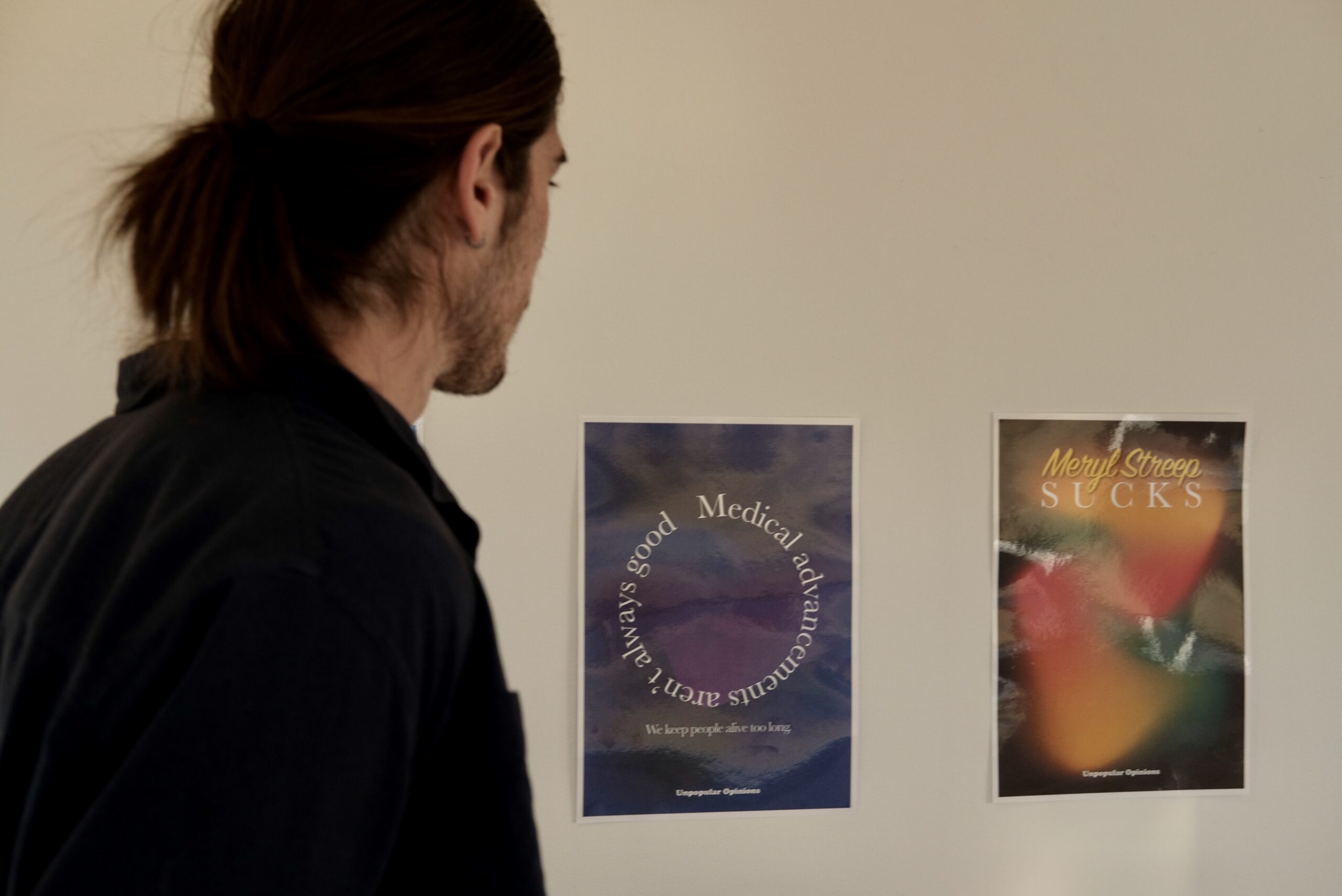
Unpopular opinions are defined as ideas and beliefs that go against or completely contradict the conventional and acceptable. These opinions may be kept hidden out of fear or shame. This work invites us to vocalize opinions that we believe we do not share with people around us. The artist solicited “unpopular opinions” anonymously on Bard Campus and then curated and designed a public display of these opinions as posters. This project questions the homogeneity of political and social opinions.
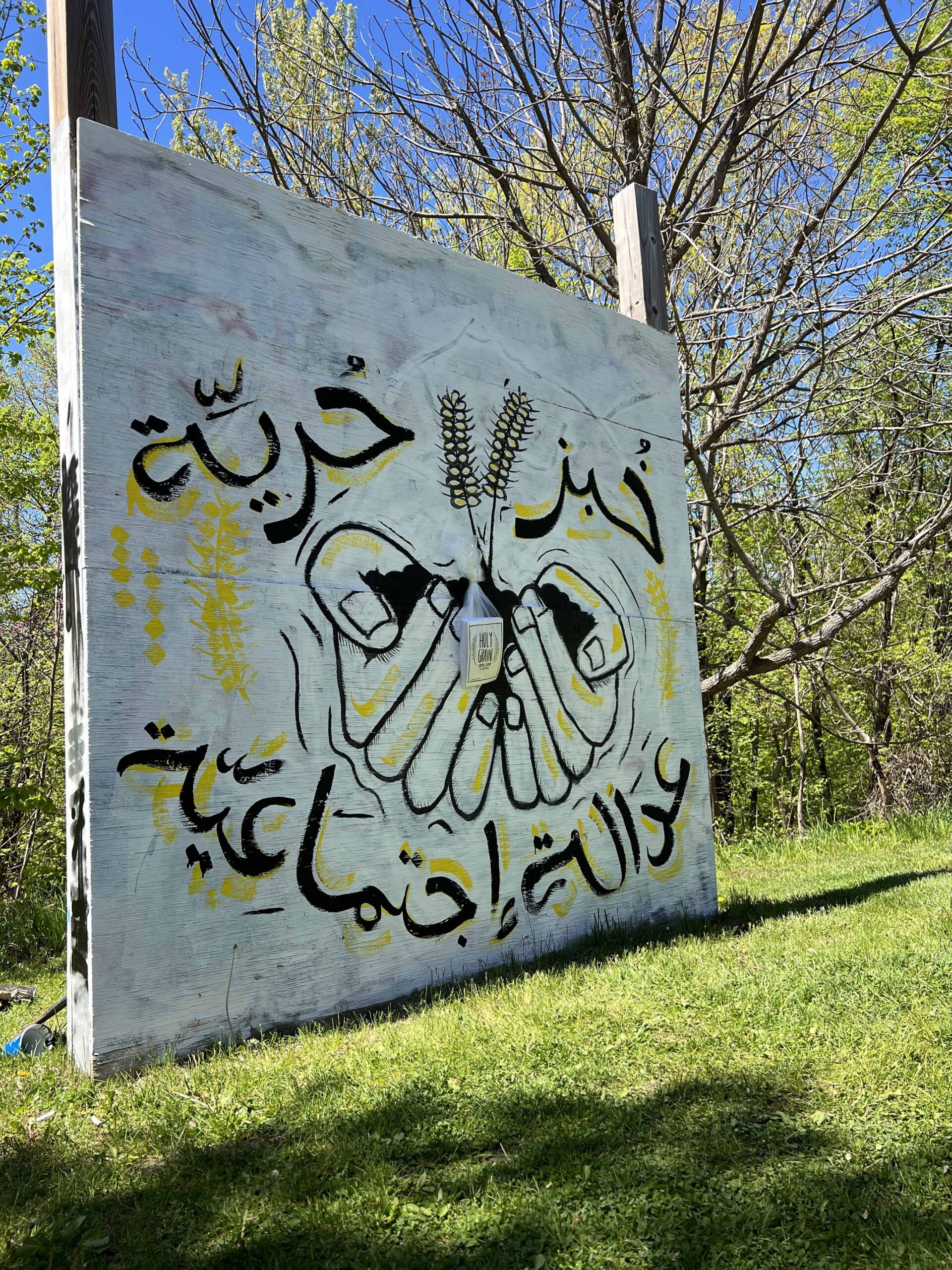
Holy Grain is a mural and accompanying zine that explores the history of bread, specifically the contemporary cultural practices that are shaped by the economic and symbolic capital of bread in Jordan and neighboring countries.
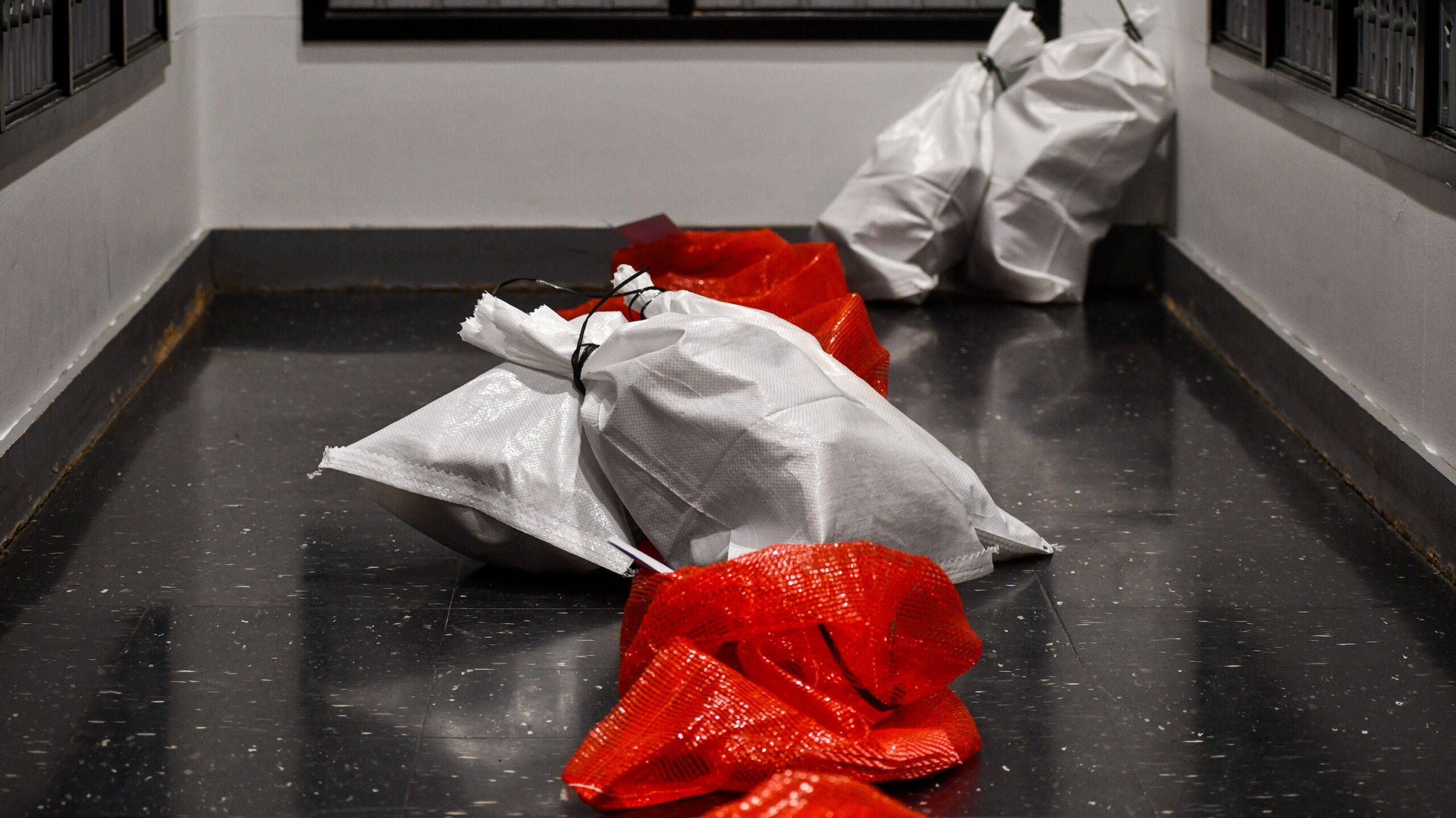
Return to Sender is an interactive installation and workshop inviting the audience to sort through years of undelivered mail coming out of the Gaza Strip. It features short letters and reviews published by Gazan guides about local places they once visited. The work aims to uncover the less visible layers of the Israeli siege on Gaza. It maps ordinary people’s lives in the strip, in hopes of recreating alternative geographies of Gaza prior to its destruction in October 2023.

Me and the Other is a lecture performance and an investigation of the world of words, and the troubling power of “compliments”. What is transmitted through remarks and small talk is frequently veiled in a history of violence and othering. Me and the Other uses humor to shed light on the contentious, intimate, and unsettling experiences of Asian women’s objectification and sexualization by the white male gaze.

Home Is A Fever is a live and immersive artwork that invites its audience to reflect on the notion of home. It explores the acts of memory and concept of time. Home being an associative and intimate concept, Home Is A Fever engages with associative notions of home and the house of its viewers while reconstructing the conventional meaning of home through storytelling, language, text, and an architectural outline of the artist’s home in Khujand, Tajikistan. Based on a personal story of a home of abuse and absence, the project reflects on the intimate experience of private spaces, being exiled either by choice or necessity, and the inability of a physical return.

Horizons is an interactive live art project in which the artist takes you on a virtual tour of his bedroom in the Dheisheh refugee camp. This sound and video installation illustrates the politics of space’s materiality, formations, and transformations in relation to political, environmental, and material violence. Horizons is about one room that influenced the architect’s perception of space and time from the building materials to the search of a wider horizon, and the unearthing of a deeply ingrained desire for escape.
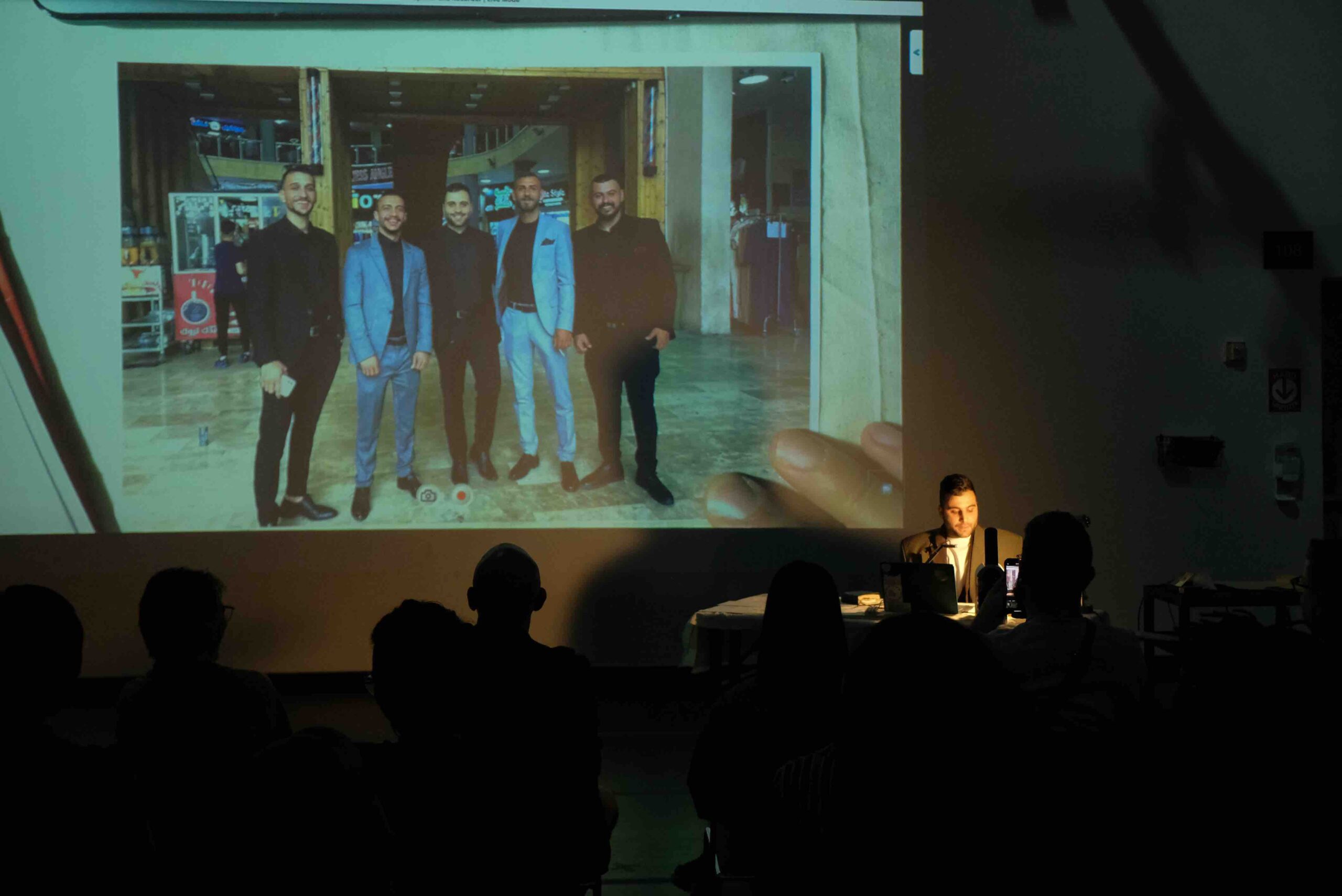
Cheap. Suit is an interactive lecture performance that explores the role of the suits and the human body in narrating the city, spatial environments, and lifestyles. Precisely, it will use the suit as a lens to trace corporate class temporalities and their intertwinement with contemporary capitalist lived experiences.

You’re invited to a cocktail party! Join us for a fiery evening of dangerous dabbling, tips and tricks, communal crafts, and do-it-yourself drinks. This participatory performance will be guided by Nour Annan. All guests must be 21 years of age or older.

Alone Time invites the audience to experience a different rendition of a familiar routine: eating takeout while consuming media through a screen. Created as a response to the romanticized communal dinners of the art world, this piece is positioned between the real and ideal of dining experiences. It explores the comfort and familiarity of this private indulgence while introducing an unfamiliar spectatorship to the space. The physical and aural presence of other bodies interrupts the ritualistic alone time, which may compound feelings of alienation or replace them with a communal experience altogether.

In this guided walk, the audience is invited near the Mahicannituck River to conduct a scientific investigation on a newly emerging parasitic arachnid. The Asian Longhorned Ticks – defined as an invasive species by the U.S. Department of Agriculture – are on the rise. Tick Drag complicates standardized ideas of invasive species in the context of settler colonies, dissolving binaries that obscure deeper structures of harm and domination.

Sunken Ground is an audio-walk in the Mahicannituck river. As glaciers melt according to current predictions, river water will submerge Blithewood gardens, erasing traces of human activity on this land. In collaboration with the Centre for Environmental Studies, Sunken Ground invites the audience to embody a future landscape, using sound to cross space-time continuums through deep history. While interrogating our [lack of] connection to climate catastrophe in the Anthropocene, this work plays on ways of seeing, feeling, and imagining alternative futures.

Opacities is an interactive live art piece that depicts what it was like to live in an apartment in the Saudi city of Hail. The artist narrates how Saudi Arabian spatial characteristics have influenced domestic settings in neighboring countries such as Jordan and Egypt through the work migration of middle-class families to Saudi Arabia. Opacities investigates the tensions between home surveillance, architectural typologies, and the obsession with privacy that is controlled by the patriarchal system and influenced by spiritual beliefs.

Waste of Land is a live performance that tracks the artist’s attempt to visit a family member’s grave in a cemetery located on the Saudi-Jordanian border. The audience is invited to join the artist in an attempt to locate the lost grave in the desert. The performance examines the relationship between political borders and transnational grave infrastructures. It also addresses the tensions between the dead body and the state.

Opus 1: because we are afraid is a duet for a cello and a heart, based on the Arabic nursery Yalla tnam [Come on, sleep], recomposed in the form of a funeral march. It is an intimate concert performed by the artist, an amateur musician, for one audience member at a time. The tempo of the performed piece is dictated by the audience member’s heart rate at the time of the performance.

Spirality is an interactive live art installation about inhabiting the land as an indigenous person on a settler colony. The work uses the form of the traditional agricultural practice of “espiral” in which seed planters give offerings to the land. The seeds hold the memories of both the land and those who eat from it.
This ritual will take place on Bard Farm. It serves as a protest and defense of the political, cultural, and spiritual processes that have been carried out on the location where the college intends to build dormitories.

In the last decade in Russia, critics of Putin’s regime have been murdered while doing their jobs of holding the state accountable. The Thread commemorates the lives and ideas of these human rights activists, journalists, and politicians. In a live drawing performance, the artist invites the audience to meet the faces and listen to the voices of those who gave up their lives for justice.

Dispatch from Exile is an immersive video installation that blends drawing, creative writing, and filmmaking. After being exiled from Russia in the summer of 2021, I turned to extensive diary writing to cope with my new reality. I found myself mourning my pre-war self and revisiting my past through my diaries. Grief is a universal experience, extending beyond losing a loved one to the loss of a homeland, freedom, or ideal. Freud argued that it’s not a pathological condition but a natural process that passes with time. Interrupting grief can lead to unhealthy melancholia. Dispatch from Exile invites the audience into my journey of coming to terms with exile and rediscovering a part of myself that I had started to forget.

Negative Exposure is an immersive installation using visual memory as a primary medium to engage visitors in examining what is seen, unseen, and erased within media representations of war. Moving through a space where images are suggested rather than displayed, the audience confronts an experience of memory reconstruction and self-reflection on the societal impulse to turn away from certain political realities. As viewers navigate altered objects, projected prompts, and contact sheets, the installation challenges visual culture’s fragile, transient nature and asks us to witness the unseen.

Learning Isabel or “everything I cannot tell you” is an interactive audiovisual installation that investigates intergenerational memory recollection as a space of struggle, particularly for queer youth growing up in Catholic family households. The piece delves into the artist’s relationship with his religious grandmother, Maria Isabel, as a means to assert the tension between a desire for identification and the refusal to assimilate into catholic heteronormativity. Curiosity and concealment overlap as Isabel’s personal memories, prompted by the encounter with old family photographs, are met with the artist’s own recollections of his unspoken queer childhood.

Performing gender normativity compels us to feel insincere, insecure, and conflicted. It leads many of us to anguish and a sense of detachment from one’s lineage. In the form of a silent disco, Inner Rave invites audiences to embody the artist’s quest for self-identification in his conservative family.

Experience the taste of Georgia and immerse yourself in a cultural feast with Baby Luka Has Finally Realized. This interactive performance is a journey through traditional Georgian cuisine and customs, where you’ll be seated at a Supra [სუფრა] table as a guest of honor. Our Tamada [თამადა], or toastmaster, will guide you through an evening of storytelling, infused with humor, wit, and SUPRAnatural magic. As you enjoy an abundance of food and drink, you will become part of the Supra’s forging of a social bond that resists the influence of external powers on Georgia and its people.

Janzeer is a live interactive live art piece that draws its experiences and aesthetics from underground kink parties, BDSM dungeons, and queer dance clubs. It is a different performative take on and a re-creation of a queer, sexually liberated, and experimental space, one that offers both freedom and alienation.
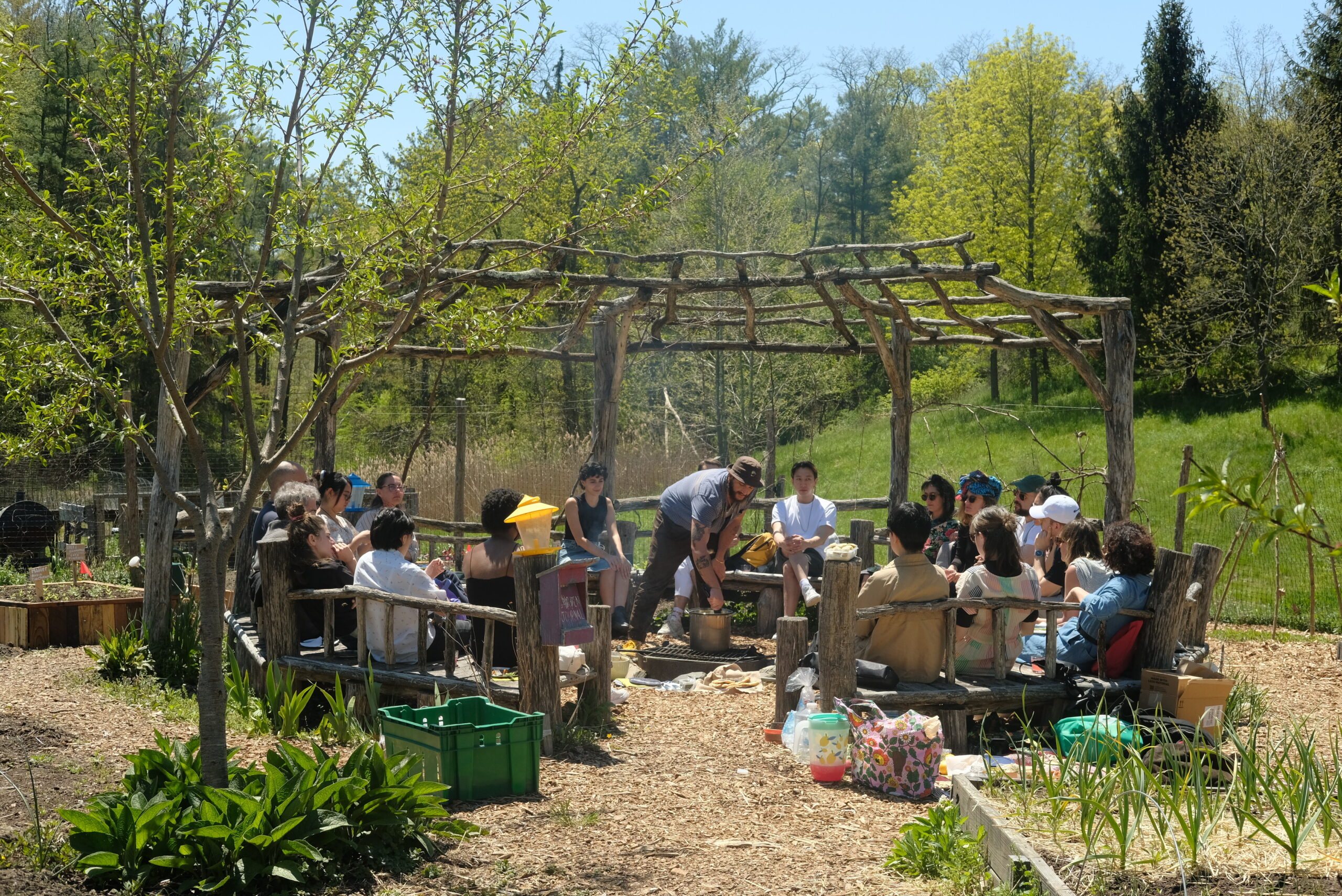
Fatal Morgana is a bonfire picnic performance examining subversive community structures and alternative organizing methods that center on agricultural traditions in Palestine. Drawing its aesthetics from outdoor picnics and camping, the performance will host a 5-course meal inspired by 5 agricultural and permacultural contemporary projects across Palestine: Riwaq, Om Sleiman Farm, Bustana, Manbata, Sakiya.

Between the Railroad and the River is an interactive art project specifically conceived for the riverfront of Tivoli, New York. It is a collection of voices from people who, in different ways, engage with the river from that special place. Visitors to the site can access the collected audio online and are invited to contribute by recording their answer to the question: “If you could speak to the river and choose a word for it, what would you say?”

A housewife from the past and an alchemist from the future (Xenia Adjoubei) invite you to a conversation on a lawn, exploring its critical and political spatial references. While lying on the grass, hanging out with friends or during a romantic picnic, we might appreciate the softness of a well-manicured lawn. Perhaps we may momentarily wonder how much water is needed to grow such grass and why it doesn’t flower. Does this soft carpet feel natural? What does it say about our society? We might feel that we are lying on an outdated American Dream, on “law and order” propaganda, on a status symbol of sexism and racism, that in times of climate change becomes symbolic of ecological destruction.

Camp is… an aesthetic, style, or genre rooted in queer drag culture. Camp is putting on your Sunday’s best: a three-piece suit in the middle of July or an extravagant headdress providing shade on the rainiest of days. Camp is colorful clothes and large fans. Camp is, come Sunday, people who live life in vastly different ways come together and put on a show. Camp is… a multimedia performance installation that seeps through various entries of Bard campus. It explores the aesthetics and politics rooted in Black sexuality, gender expression, and queer drag culture in relation to Black American megachurches’ self-fashioning and respectability.

World Light Heavyweight Champion takes on the battle of the year against an old foe! They’ve prepared for this moment all year long. We’ve been patiently waiting. It is all about to explode in a fight that surely will go down in history. Get your tickets! Tune in! Show up to finally see two massive beasts completely obliterate one another. RiSE. TOP. DOMiNATE. is an immersive live performance.
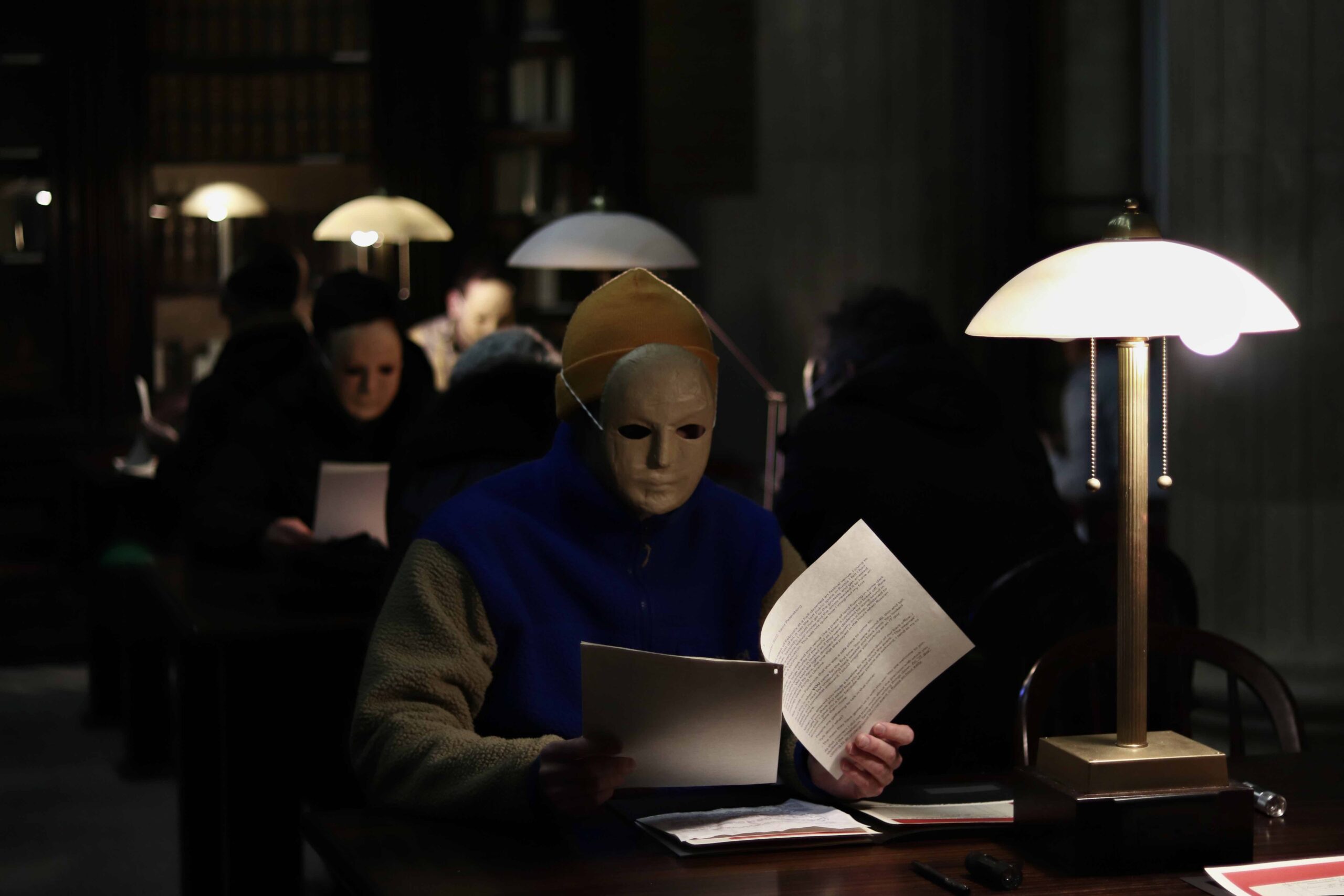
What happens when an authoritarian state comes to your art venue blending with the audience? Do you censor yourself, set a trap, or see a potential for communication? To The FSB Officer Who Attended My Events is an immersive installation that tells a story of an art festival that opened in February 2022 when Russia invaded Ukraine. It challenges the notion of safe spaces and addresses the fact that Russian security agents are regulars at certain artistic occasions.

Cranes and Ships is a poetry film that takes its name after a children’s poem by Daniil Kharms, a repressed Soviet writer. The film ponders the silences and small acts of resistance by anti-war Russians at a time when mass protest fails, when the state introduces military censorship, and the full-scale war is not experienced directly. The film seeks to approach the variety of ways in which the war uproots people – even when they are not displaced physically.
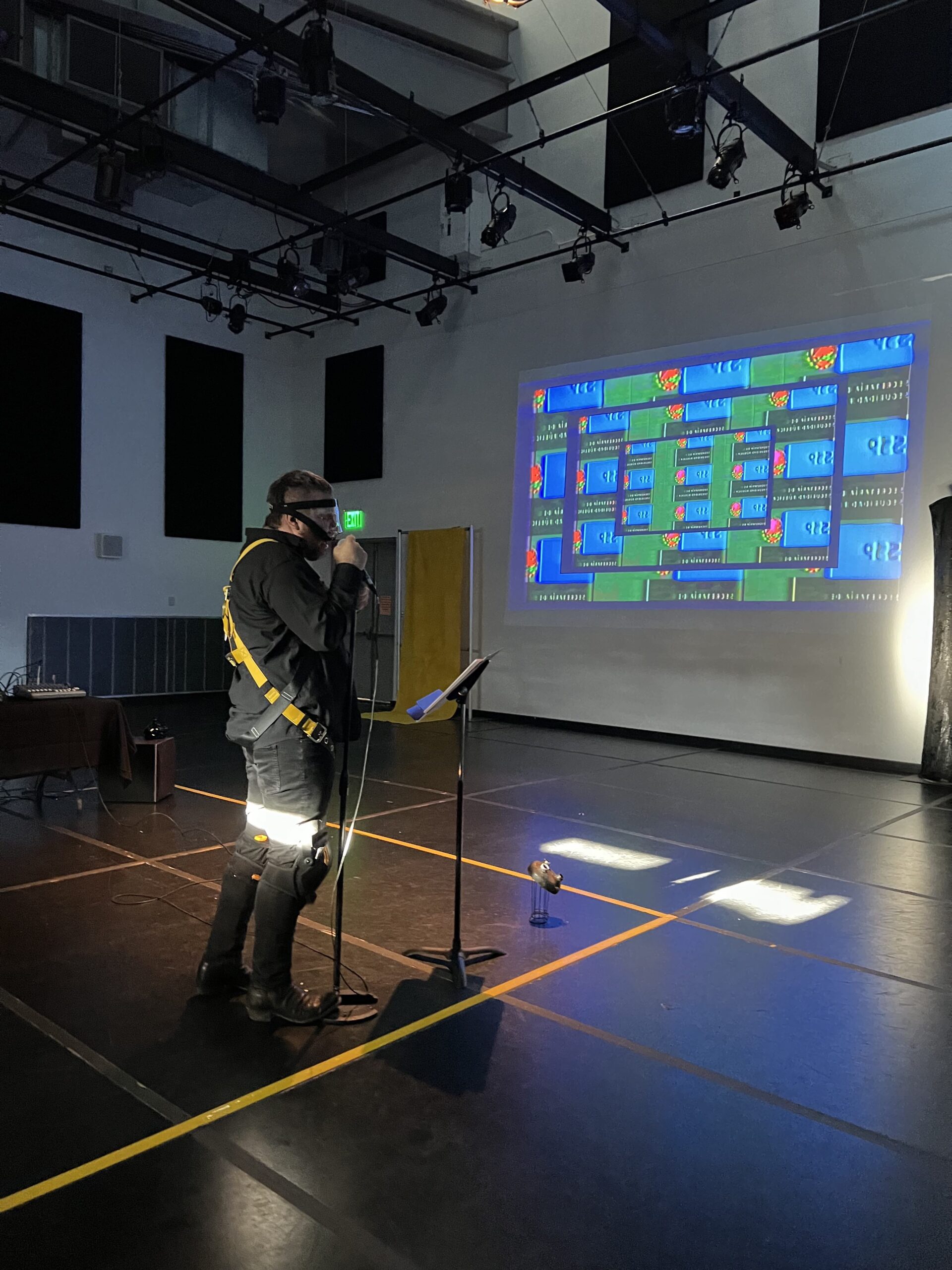
After the death of RUFIAN, the invocation of its undead presence and the demise of the fifth sun, the initiatory rite of the black sun, births the invisible made visible, the rumbling ground, the enemy, the mirror of smoke, shadow jaguar, the faceless Cerebro. Live Music by CEREBRO : A.K.A. RUFIAN, Acid Sludge, Post Industrial genre from the Ciudad Juarez, Mexico, Subterranean Scene, Soundtrack to the Urban Warfare. The set will consist of material written, composed and produced in New York as well as unreleased material marking the rise of CEREBRO : . after the initiation and death of RUFIAN.

The food we cook reflects a search for belonging. In the context of displacement, mobility, and immigration, it can be difficult to replicate recipes in places far from home. In this performance meal, Baitsai Luo explores the taste of home in exile and distance, and how our cultures are represented through food. Inside Baitsai’s cozy living room, the audience is served three dishes and a drink, all originally from China, while listening to Luo’s humorous stories and recollections.

Welcome to an authentic cacao ceremony. Let’s share the gifts of Mother Earth and the healing of the sacred cocoa surrounded by music, dance, and meditation. This special ceremony is designed uniquely for you (below the regular price), but donations are encouraged. We only offer genuine ceremonial cacao powder bought from Guatemala. *Disclaimer: The organizers are not responsible if you experience any psychic response.

Howls in the Mountains is a video installation that features the experiences of women who are former members of the Revolutionary Armed Forces of Colombia — People’s Army, the guerilla group known as FARC. In the wake of the FARC’s peace agreement with the Colombian government in 2016 and its formal disarming in 2017, these women shifted their activism and currently work on a number of different community projects throughout Colombia, focusing on gender equality, environmental protection, and social justice. The video installation combines these women’s stories with images of their home communities, creating a visual-social experiment inspired by their personal experiences and psychogeography.

Skins of Nature is an endurance performance piece that takes place in the open fields of the Hudson Valley on Bard College, the unceded lands of the Munsee and the Mohican people. The performer worked with multiple square bales of hay, using her body to transform them and move them through the landscape producing a trace in time and space, creating an altar for all those who perished in anonymity. This intervention honors the spirits of the ones who died here under the whip of the white man.

Digital Dystopias reflects on the problematic practices in digital culture, such as surveillance, doxing, and impersonation. These practices altogether contribute to the alarming tendency to devalue human life. Since all of our behavior online is converted to data, we become reduced to lines of binary code in the database. Our personal information enters the veins of the system’s algorithms to further digitize our being. Digital Dystopias is a transcendent posthumanist take on our current relationship with the digital world. In an unnerving immersive lecture-performance, the audience is taken through the process of data production to illustrate the creation of digital traces and the fragility of human life in the data-driven world.
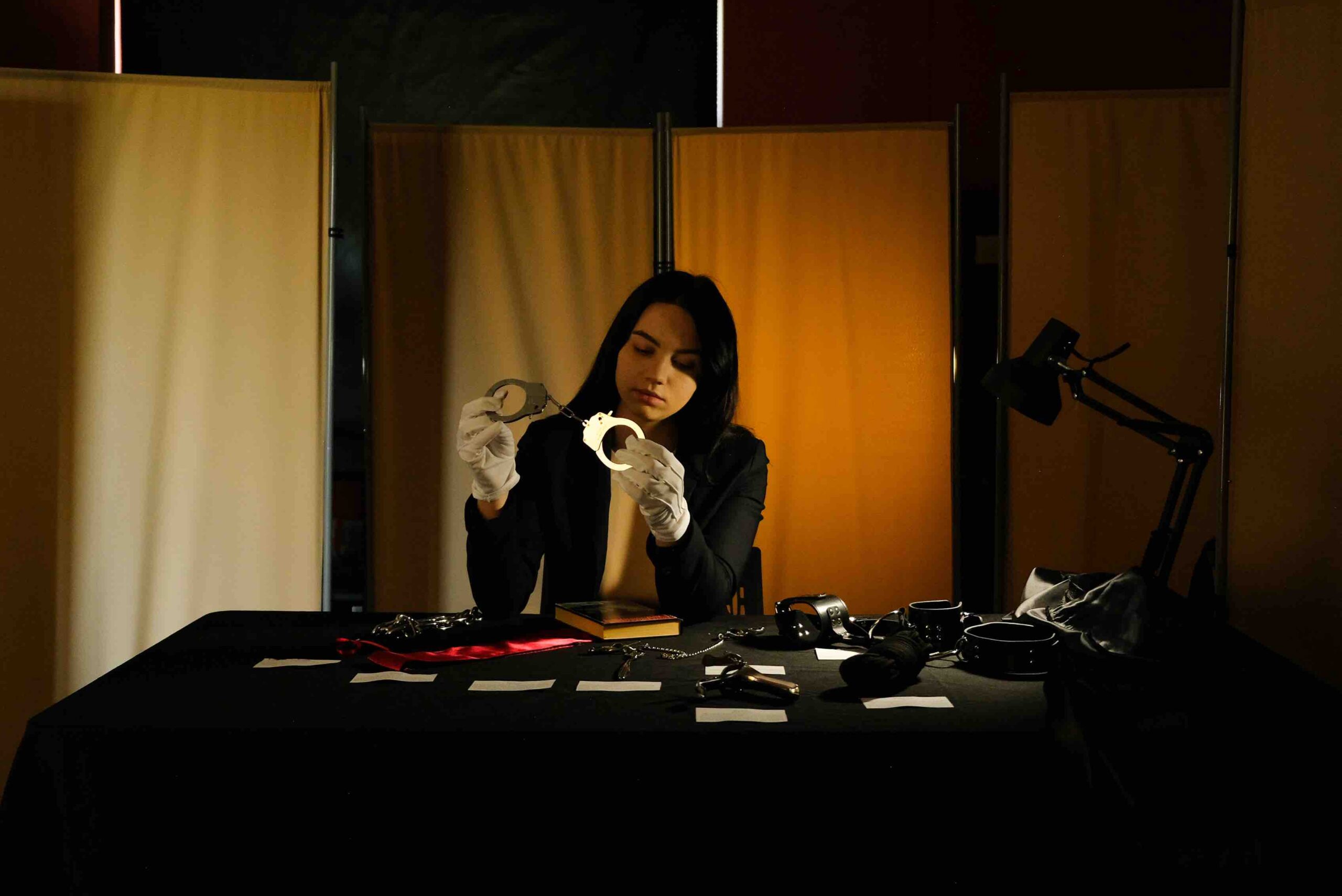
Body Politics invites the audience to a lecture performance situated in a fictitious museum where borders between concepts become blurred. What does it mean to have a body in an intermingled net of political effects? How do our immediate bodily experiences, such as pain and pleasure, get enmeshed in power relations and exploited in different practices. This project explores the corporeality of being and reflects on the historical developments around both the protection and violation of bodies.

Laundering “Hpone” is an installation exploring the anecdotal superstition around Hpone in Myanmar. Hpone is the belief of a mystic power that only men possess, and is threatened by the mere touch of another gender’s clothes. This concept shaped Myanmar’s traditions and behaviors, painting menstruation as ‘dirty’, keeping women away from sacred places, and guiding the strict rules of domestic laundry.
Through personal memories and myths recollection, Laundering Hpone engages with the recent use of women clothings as a form of political resistance in post-coup Myanmar. It examines the collective effort to redefine and resist patriarchy, male fragility and state violence.

Undesirable Bingo is an interactive performance that challenges the very concept of undesirability introduced by the Russian federal law that suppresses those running contrary. In the context where dissent is squashed and critics are labeled as enemies, it takes the shape of a competitive game to reclaim the idea of undesirability as a badge of honor.
Who will be the first to get the undesirable row as determined by the vague and sometimes random criteria of the Russian government? This performance is an ironic take on the absurdity of government censorship and a celebration of the brave.

Mesopotamia, 4000 BC, the inscription of signs representing ten goats and sheep on a clay tablet set up the emergence of what will become an integral part of literacy: reading. Several centuries later, arranging pages in a booklet shaped the birth of books as we know them. Since then, they have taken many shapes and functions. [TL;DR] is an interactive performance where the audience is invited to use the library as a playground and to experience a scavenger hunt. The performance questions access to knowledge in order to consume books in an alternative way.

Of Rust and Starch is an immersive video installation that portrays the relationship between Fridge and Batata, a speculative fiction depicting a non-human bond between two non-sentient beings. This project is an attempt to question the notions of aging and expiration time in the age of mass consumption, while speculating about possible links that can take place between objects that are overlooked by humans.

A bathroom is a place of comfort, but also an opportunity for regaining control by celebrating/recognizing one’s body away from the male gaze and the pressure of being constantly vigilant. My Mind in a Bathtub is an autobiographical performance, exploring the role of intimate spaces as refuge for women who feel watched by society.

Ten More Minutes sheds light on the immense struggles that Palestinians face when it comes to accessing healthcare due to the Israeli occupation. The story takes us back to May 1st, 2019, when Salma, a 13-year-old girl, and her father were on their way to Hadassah Hospital in Jerusalem. To get there, they had to pass through the 300 Checkpoint that separates Bethlehem from Jerusalem, which serves as a crucial component of Israel’s colonial security infrastructure. This checkpoint acts as a barrier erected by Israeli Security, further complicating the already challenging journey for Palestinians seeking medical assistance. As Salma describes the incidents that occurred on their trip, we get a glimpse into the harsh reality of life under occupation. IDs are required to enter the performance space.

Capitalism and “yard waste” continue to keep many of us from feeling safe here. Leaves, essential components of ecological cycles, are removed from their place of origin—pushed out, collected, and transported elsewhere. This displacement fuels a system of extractive landscaping reliant on fossil fuels and human labor. Along the Mahicannituck River, the aesthetics of the empire remain entrenched, enforcing control over “nature” and turning it into a cooperative, tidy subject for human convenience.
Ecosystem Plot Twists are actions that divest from settler colonial landscaping practices and embrace decomposition and play as a form of resistance. Through playful interventions and intentional neglect, this project envisions a return of land to the forest, undoing the separation of leaves and soil from their natural processes.

Olovo is a country that does not exist. This is an immersive interdisciplinary project that occupies Bard Campus Center for the duration of 24 hours. It employs the main mechanisms of occupation of Russia and the Soviet Union, with emphasis on the current war on Ukraine. Olovo includes a series of installations and performances, as well as an Instagram account (@olovobard) and propaganda posters on campus. The work reflects on the practices of occupation, exposing how in a short period the occupier transforms a local culture and enacts a spatial and narrative dominance.

In 2020 millions of Belarusians took to the streets to protest the electoral fraud that granted dictator Alexander Lukashenko president for a sixth term. Since then thousands of Belarusians have been arrested and tortured, with the Viasna Human Rights Center recognizing almost 1,500 people as political prisoners. It is crucial to understand how circumstances would have been different if, in 2020, the war criminal Vladimir Putin did not support the dictator Lukashenko, and missiles could not fly from the territory of Belarus into Ukraine. The installation Zhyve Zhyve reflects on the 2020 events, through textile and a collection of clothes that conveys to the audience the expressed will of the Belarusian people.

Little Lamb is a new kind of church service—one where the Songbird Supreme, global superstar, and gay icon Mariah Carey is our Lord and Savior. The performance takes inspiration from the artist’s experience: a Catholic upbringing in Boston, Massachusetts, that led to a secular search for faith in gay iconography. The artist — drag performer Melissabeth — assumes the role of the Priest, dahlings, leading the audience through selections from Mariah’s music catalog, an autobiographical sermon, and an offering of Mimi’s festive spirit through symbolic food and drink. Little Lamb asks: can the stale structures of a Catholic mass lay the foundation for something new and beautiful?

Bruce, the American Lobster leads the audience through a lecture-performance that traces the changing cultural perception of lobsters throughout time—from overabundant marine protein to pauper’s food, and from luxury commodity to sentient being. Market Price explores the politics of seafood, class, immigration, geography, technology, and animal perception.

This Is How the Besieged Play is a minimalist installation and an interactive nonevent exploring disrupted childhood playfulness and the making of absence by modern warfare. The audience is invited to be both players and spectators in a football game that shall not be played. The work conjures both a scene from the artist’s memory of chasing a ball on the family’s lawn before the war on Iraq, and the site of the playground-cum-Martyrs’ Cemetery of Fallujah, where many civilians, including children, were laid to rest during two American assaults on the city in 2004.

Through My Window is an interactive audio installation using everyday soundscapes collected from various locations in the Hudson Valley, accompanied by a narration on navigating trauma-triggering soundscapes. The audience is invited to listen to the audio through headphones while observing the outside scenery through a window. This work considers how we engage with sound in our daily lives—whether through urban noise, media, or sounds we often overlook—in order to become more aware of the psychological and emotional effects of sound on people who live with war trauma.
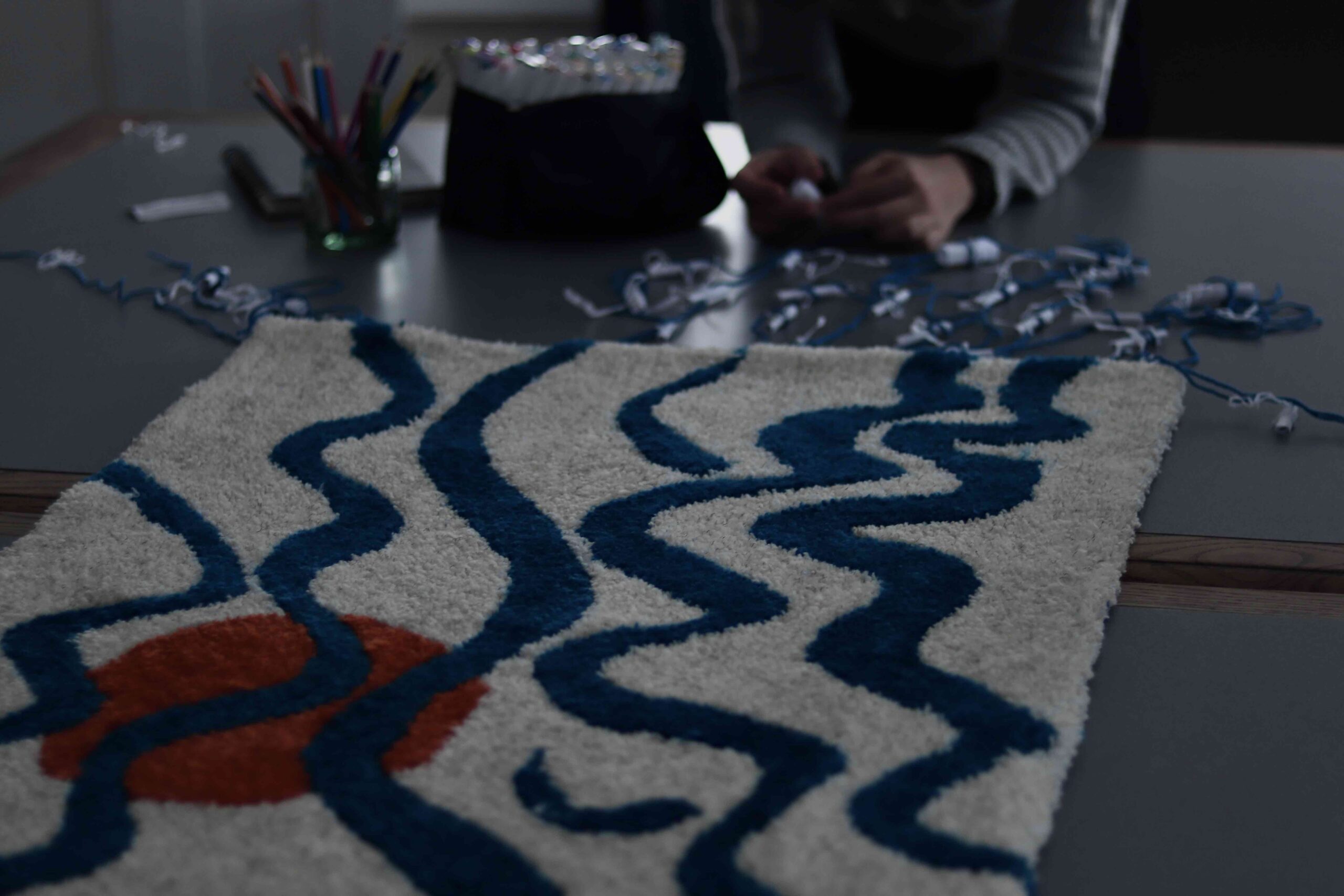
This one-to-one performance is a collaboration between two Libyan artists in exile conversing about home in the context of climate change, pandemic, and displacement. Through the creative process of weaving a therapy rug, they map home as a place where geography no longer makes sense; where home is a place between the stars and the ocean is a place nearby. The audience is invited to reflect on the concept of home, through visualizing their places, and sketching them in a book.

Mozart said, “The music is not in the notes, it is the space between the notes.” So what exactly goes on in between the notes? It’s not always a literal silence, is it? Each note is usually still ringing out before the next one is played, right? But yes, something is happening that relates to silence. We are listening to the sound of Silence. The space between notes allows them to resonate, reverberate, and reach their full measure of expression. The invisible yet visible silence of the symphony of melting ice. The urgency of the slow violence of the sounds of the cracking ice can be another way of communicating knowledge to the audience, a different way to experience nature through music and visuals.

As We Bleed is a multi-sensory installation exploring the political tensions that burden menstruators. Audience members are invited to listen to the experiences of stigma, demonization, and celebration of menstruation. The work challenges cultures that deprive those who menstruate safe spaces and diminish their access to their bodies. The audience is invited to share vulnerability while exposing systems of inaccessibility and period poverty.

Bleeding into My Dreams is a multi-medium short story that follows Onaye, whose menstrual cramps awaken in her the embodiment and inhabitation of uMakhulu (Grandmother). uMakhulu fills her spirit, her breath, her voice, and her body. I invite the audience to help me trace Onaye’s idiosyncratic inheritance that welcomed her to remember. Remember amaphupho kaMakhulu.

The prison experience is understood to be isolating and depriving of visual stimulation. Prisons are not quiet places where reflection and reparation occur. Incarcerated people develop a special sensitivity to sound. In a place where their bodily agency is restricted, listening –or refusing to– is a political act. Based on his friend’s recollection of detention sounds, the artist recreates soundscapes that have been weaponized by both the detainees and their guards, as tools of surveillance and resistance. By addressing misconceptions of detention and focusing on prisoners’ knowledge, this aural experiment is a reflection towards prison abolition and the damage and futility of punishment.
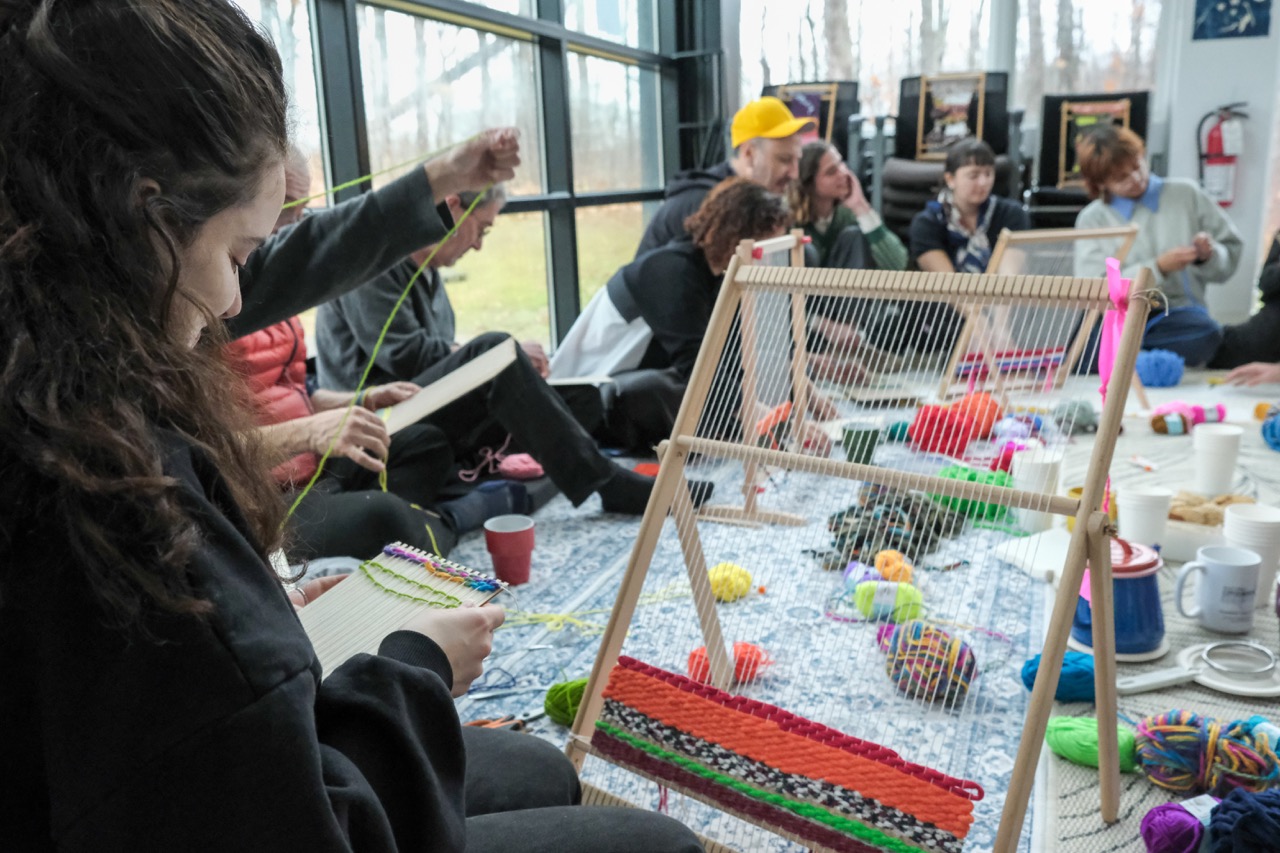
Interwoven is a community gathering inviting the audience to practice handweaving, one of humanity’s earliest technologies. During the gathering, participants will be informed about the basics of handweaving and invited to collectively create handwoven objects using looms and various materials. This gathering utilizes handwork and weaving as a community-building practice. Interwoven revolves around the politics of touch, handwork, and communal labor.
Developed in conversation and with support of Hand to Mouth Weavers, Red Hook.

Sound Bounds is an interactive live art piece that invites the audience to collaborate with the artist on a dialogue through sound making. Across a wall in an open field overlooking the Catskills, this dialogue is shared between audience and artist using random objects and musical instruments to make sound, with the sounds of nature as a backdrop. This piece is inspired by the potential for resisting human-constructed political borders through sound and communication.

The Patapsco Inn is a re-creation of a found vintage menu and an accompanying sound piece, experienced in person and online. The piece explores the experience of growing up in a family-owned restaurant-bar in Catonsville, Maryland in the 1950s. This work is a collaboration with the artist’s mother and grandmother. The Patapsco Inn explores restaurants and bars as gathering spaces, as well as the functionality of familial memory and legacy.

LILA is a performance that reclaims the act of crying as a source of collective strength. By evoking ancestral mourning rituals and the primordial connection to water, the desire is to braid a space where vulnerability and communal grief are embraced. The audience is invited into a ritual that the artist can or cannot recall. What can be offered against the weight of anger, trauma, sadness, and despair? Together we will prepare the space where one can honor and celebrate those who few can still see; the dead.

Last seen on 23 June 1611 is an immersive audio tour exploring the dispossession of the People of the Waters that Are Never Still.
On their first stay at a settler colony, the artist embarks on a journey using interviews and archival sounds, to trace the early 1600s and the colonization of the Mahicannituck. The site-specific audio piece invites the audience to reflect on the politics of disappearance by engaging with the topography of the land.

Naked Sword is a safe space built around negative perceptions of the body, sexuality, and sex, showcasing political, social, and personal narratives concerning people who are alive, sensual, and untouchable. Naked Sword wrests the body from the hands of political puppeteers, social stigma, and leaves the decision to the viewer: temptation, desire, shyness, or embarrassment?

Queer Kurultai offers a queer perspective on Kyrgyzstani traditions, socio-political relations, and the place of LGBTQ+ community. During a dinner gathering featuring Kyrgyzstani national dishes, the guests will hear snippets of stories and reflect on them together. This piece is inspired by the debate on gender standards and roles in Kyrgyzstan society, and their implication in the growing political homophobia in the country and beyond.